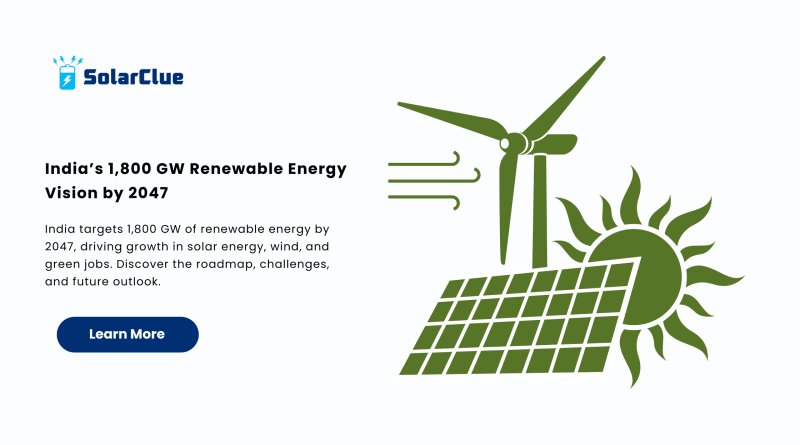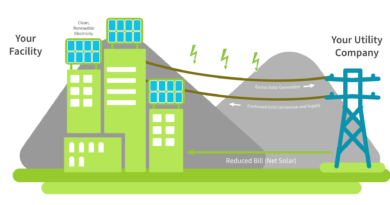India’s 1,800 GW Renewable Energy Vision by 2047
India’s 1,800 GW Renewable Energy Vision by 2047: India is charting a bold and transformative path toward clean energy with a visionary goal—achieving 1,800 GW renewable energy, by 2047. This ambition not only aligns with India’s long-term decarbonization targets but also signals a pivotal shift in how the country plans to meet its growing energy demands while addressing climate change.
Table of Contents
Why This Target Matters
By 2047, India will celebrate 100 years of independence. The government’s plan to install between 1.8 TW and 2 TW of renewable energy by then is not just symbolic—it’s strategic. With rapid urbanization, industrial growth, and rural electrification, energy needs are expected to surge. Meeting this demand sustainably means turning to solar energy, wind power, and other renewable energy sources.
Today, India generates 243 GW of power from non-fossil fuel sources, already surpassing its 2030 target of achieving 50% non-fossil-based capacity—five years ahead of schedule. This achievement sets a strong foundation for the journey toward 1,800 GW renewable energy, by 2047.
The Role of Solar and Wind Power in India’s Energy Future
India’s clean energy transformation is heavily anchored in solar power and wind energy. Here’s where the country currently stands:
-
Solar module manufacturing capacity has reached 91 GW, with another 10-15 GW in development.
-
Solar cell manufacturing stands at 25 GW and is growing.
-
Wind turbine manufacturing has hit 18 GW, though it lags behind solar in scaling.
Under the Approved List of Models and Manufacturers (ALMM), the Ministry of New and Renewable Energy (MNRE) added 742 MW of module capacity recently, bringing the total to 91,458 MW. This growth reflects the government’s push for domestic manufacturing and its ambition to become a global solar energy hub.
However, the domestic wind market still requires attention. While India has wind potential, the growth in wind component manufacturing is slower compared to solar. A balanced approach is necessary to ensure a diversified renewable energy portfolio.
Energy Storage: A Critical Gap
Despite rapid strides in generation capacity, energy storage remains a weak link in India’s clean energy roadmap. Although India aims to achieve 236 GWh of energy storage capacity by 2032, it has yet to cross the 1 GWh mark.
This gap is significant. As solar and wind are intermittent sources, storage solutions like batteries are essential for maintaining grid stability and ensuring 24/7 power supply. Investments in storage technology, alongside supportive policy frameworks, are urgently needed.
Challenges Hindering Growth
Several real-world challenges stand in the way of this ambitious goal:
-
Grid integration complexity: As more variable renewable energy is added, maintaining balance in the grid becomes difficult.
-
Land availability: Large-scale solar and wind farms require significant land parcels, often facing issues with land acquisition.
-
Transmission infrastructure: Without strong and flexible transmission networks, delivering renewable power to demand centers is inefficient.
These challenges require coordinated efforts between the central and state governments and active participation from industry stakeholders.

Green Jobs and Workforce Skilling
Transitioning to renewable energy doesn’t just mean more power—it means more jobs. According to the MNRE, green jobs in the renewable sector can generate 5–10 times more employment than conventional fossil fuel-based projects.
Under the PM Surya Ghar program, over 100,000 ITI students were trained in solar installation and maintenance last year alone. Now, the government aims to establish 100 dedicated renewable energy ITIs to meet the rising workforce demand.
This “green skilling” initiative ensures that as the industry grows, India has a ready and capable workforce to support it.
Government Commitment and Global Implications
India’s renewed commitment to 1,800 GW of renewable energy by 2047 reflects its global responsibility under the Paris Agreement and other international climate frameworks. It sends a strong signal to investors, global clean-tech firms, and international partners that India is serious about leading the energy transition.
The country’s ability to meet or exceed these goals will have far-reaching implications—not just for climate outcomes, but also for its position as a global economic and industrial powerhouse.
India’s 1800 GW Renewable Energy Vision by 2047 FAQs
1. Why has India set the 1,800 GW renewable energy target for 2047?
To meet rising energy demand, reduce carbon emissions, and align with global climate goals while celebrating 100 years of independence.
2. What is the current renewable energy capacity in India?
India has achieved 243 GW of non-fossil fuel capacity, which includes solar, wind, hydro, and nuclear sources.
3. How much solar energy is India generating currently?
While specific figures fluctuate, solar power forms a large portion of India’s renewable mix, with 91 GW of module manufacturing capacity and over 70 GW installed capacity as of recent data.
4. What challenges does India face in reaching its 2047 target?
Key issues include land acquisition, grid integration, transmission bottlenecks, and insufficient energy storage infrastructure.
5. How is the government supporting green jobs?
Through programs like PM Surya Ghar, ITI skilling, and plans to launch 100 renewable energy-focused training institutes.
India’s 1,800 GW Renewable Energy Vision by 2047 is bold, necessary, and inspiring. It represents not just a change in technology, but a shift in mindset—from fossil fuels to a sustainable, inclusive, and economically robust future. This is not just about energy—this is about India’s legacy for the next 100 years.
Want to stay updated on how India is transforming its energy future with solar power and more? Dive deeper into the clean energy movement at solarclue.com or explore industry insights at blog.solarclue.com.




